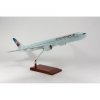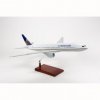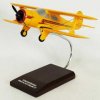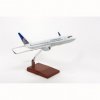"The Boeing 777 is a long-range, wide-body, twin-engine American airliner built by Boeing Commercial Airplanes. The Boeing 777 was originally a stretched 767. Boeing 777's notable design features include a unique fuselage section and it incorporates a fly-by-wire, an advanced technology glass flight deck with five liquid crystal displays. 777-200 is powered by two Pratt & Whitney PW4077 turbofans, General Electric GE90-77Bs or Rolls Royce Trent 877s. The basic 777-200, which is the initial A-market model, was launched on October 1990 and was offered in two versions, the basic 777-200 and the increased weight longer range 777-200IGW which was redesignated as the 777-200ER. 777-200's maiden flight was on June 12, 1994 and received its FAA and JAA certification on April 19, 1995. 777-200 was first delivered to United Airlines in May 1995 and the first 777-200IGW/ER was delivered to British Airways in February 1997. The Boeing 777-200 has a typical cruising speed of 905 km/h and a range of 229 tonne MTOW 7000 km. It has a flight crew of two and a seating capacity for 305 in three classes or up to 440."
Scale: 1/100 scale model
Wing Span: 24
Length: 26
KB777AATR
|
"The Boeing 777 is a long range, wide-body twin-engine airliner manufactured by Boeing Commercial Airplanes. The world's largest twinjet and commonly referred to as the ""Triple Seven"", the aircraft can carry between 283 and 368 passengers in a three-class configuration and has a range from 5,235 to 9,380 nautical miles (9,695 to 17,370 km). Distinguishing features of the 777 include the six wheels on each main landing gear, its circular fuselage cross section, the largest diameter turbofan engines of any aircraft, and the blade-like end to the tail cone. The Boeing 777 is produced in two fuselage lengths. The original 777-200 model entered service in 1995, and the stretched 777-300, which is 33.3 ft (10.1 m) longer, was introduced in 1998. The longer range 777-200LR and 777-300ER variants entered service in 2006 and 2004, respectively, while a freighter version, the 777F, first flew in 2008. Both long range 777 models and the 777F are equipped with wingtip extensions of 12.8 ft (3.9 m) and raked wingtips. The 777-200LR is currently the world's longest range airliner, and holds the record for longest distance flown by an unrefuelled commercial airliner. Through the 2000s, the Boeing 777 has emerged as one of its manufacturer's best-selling models. As of October 2008, 56 customers have placed orders for 1,096 777s. Due to rising fuel costs, airlines have acquired the 777 as a comparatively fuel-efficient alternative to other widebody jets, and have increasingly used the aircraft on long-haul, transoceanic routes. Direct market competitors to the 777 are the Airbus A330-300, A340, and A350 XWB, which is currently under development The stretched A-market 777-300 (773A) was designed as a replacement for 747-100s and -200s. Compared to the older 747s, the stretched 777 has comparable passenger capacity and range, and was designed to burns one third less fuel and have 40% lower maintenance costs. The 777-300 features a 33 ft 3 in (10.1 m) fuselage stretch over the baseline 777-200, allowing seating for up to 550 passengers in a single class high density configuration. The 777-300 is also 29,000 pounds (13 tonnes) heavier, is equipped with a tailskid, and includes ground maneuvering cameras mounted on the horizontal tail and underneath the forward fuselage to aid pilots during taxi due to the aircraft's length. The typical operating range with 368 three-class passengers is 6,015 nautical miles (11,135 km). The 777-300 is powered by the following engines: 90,000 lbf (400 kN) PW4090 turbofans, 92,000 lbf (409 kN) Trent 892 or GE90-92Bs, or 98,000 lbf (436 kN) PW-4098s. Since the debut of the 777-300, a total of 60 -300s have been delivered to eight different customers, and all were in airline service as of August 2008. However, following the introduction of the longer range -300ER in 2004, all operators have selected the ER version of the -300 model. The 777-300 has no direct Airbus rival, but the A340-600 is offered in competition."
Scale: 1/100 scale model
Wing Span: 24
Length: 26
KB777ACTR
|
"The 777-200 brings the comfort and economic advantages of the Boeing 777 to non-stop routes that have never before been possible. The first 777-200LR was unveiled in February 15, 2005. Its maiden flight was on March 8, 2005 and has began a six-month flight-test program. The 777-200 gained certification from the FAA on April 19, 1995. On November 20, 1996, in Seattle, Boeing announced and confirmed for 10 orders of Boeing 777 jetliners. The Air France Airline will add 13 Boeing 777-300ERs passenger aircraft and five Boeing 777 Freighters. The five freighters are in addition to five 777-200 cargo aircraft to be delivered this year, replacing the 747-200 freighters. The first Boeing 777 will be delivered to Air France. Air France chose the 777-200 Increased Gross Weight (IGW) model designed for longer routes than the initial 777-200. The new longer-range 777-200 was launched in February "
Scale: 1/100 scale model
Wing Span: 24
Length: 26
KB777AFTR
|
"The Boeing 777 is a family of long range wide body twin engine airliners built by Boeing Commercial Airplanes. It carries between 305 and 550 passengers and has a range from 5,600 to 8,870 nautical miles (10,400 to 16,400 km). The first flight of the 777 was on June 12 1994. Distinguishing features of the 777 include the set of six wheels on each main landing gear, its perfectly circular fuselage cross section, and the blade-like rear tail cone. The Boeing 777 was first introduced on June 7 1995 with United Airlines. The 777-200 (772A) was the initial A-market model. The first customer delivery was to United Airlines (FAA: N777UA) in May 1995. It is available with a maximum take-off weight (MTOW) from 505,000 to 545,000 pounds (229 to 247 tones) and range capability between 3,780 and 5,235 nautical miles (7,000 to 9,695 km). The 777 was the first commercial aircraft to be designed 100% by computer. No paper drawings were ever produced; everything was created on a 3D CAD software system known as CATIA. This allowed a virtual 777 to be assembled in cyberspace, allowing engineers to examine for interferences, and to test if the many thousands of parts would fit together properly before costly physical prototypes were manufactured. The Boeing 777 currently is available in six models: 777-200, 777-200ER (extended range), 777 200LR (longer-range), 777-300 and the 777-300ER, and the 777 Freighter. "
Scale: 1/100 scale model
Wing Span: 24
Length: 26
KB777CATR
|
"The basic Boeing 777-200 was offered in ""A"" market and increased gross weight ""B"" market versions, in which the version became the Boeing 777-200ER. There were four versions of the 777 available; the stretched Boeing 777-300, the longer-range Boeing 777-200LR and -300ER and the Boeing 777 Freighter. The Boeing 777 was the first Boeing aircraft in which potential customer airlines were involved with the design. There are about 43 airlines worldwide which placed 849 orders for all versions of the Boeing 777. The Boeing 777-200 can accommodate 268 passengers. It has a cruising speed 550 mph and a range of 8,150 miles. The 777-200 incorporates 2 Rolls Royce Trent 892"
Scale: 1/100 scale model
Wing Span: 24
Length: 26
KB777DNTR
|
"Boeing 777-200 incorporates more advanced technologies than any other previous Boeing airliners and has been progressively developed into increasingly longer range developments. Boeing describe their 777 models using two characteristics: the first is the size of the fuselage affecting the number of passengers and the the amount of cargo that can be carried. The second characteristic is the range. Boeing incorporates advanced technologies in the 777's features including Honeywell LCD glass cockpit flight displays, fully digital fly-by-wire flight controls with emergency manual reversion, fully software-configurable avionics, electronic flightbag, use of composites, fiber optic avionics network and the largest, most powerful turbofan engines and the largest landing gear. The 777-200 was launched on October 1990 and was available in two versions, the basic 777-200 and 777-200IGW. It has been redesignated as the 777-200ER. The 777-200LR variant (Longer Range) is the world's longest range commercial airplane and in 2000, was listed as one of the top 100 list in Popular Science Magazine. The 777-200 was the initial A-market model. The 777-200's maiden flight was on June 12, 1994, and was granted certification by the FAA and JAA on April 19, 1995. The basic 777-200 was launched in October 1990. The United Airlines was the first customer of the 777-200 and was delivered to them in May 1995. In February 1997, the first 777200IGW/ER was delivered to British Airways. The 777-200 is powered by two 77,000 Pratt and Whitney PW4077 turbofans. It has a typical cruising speed of 905 km/h and has a range of 229 tonne. The 777-200 has a flight crew of two and has a seating capacity for 305 in three classes or up to 440. There is approximately 40,000 cubic feet of volume in a 777-200. As of 2003, a total of 452 777-200 orders were received, with 379 delivered."
Scale: 1/100 scale model
Wing Span: 24
Length: 26
KB777UA2TR
|
"The Boeing 777 is a family of long range wide body twin engine airliners built by Boeing Commercial Airplanes. It carries between 305 and 550 passengers and has a range from 5,600 to 8,870 nautical miles (10,400 to 16,400 km). The first flight of the 777 was on June 12 1994. Distinguishing features of the 777 include the set of six wheels on each main landing gear, its perfectly circular fuselage cross section, and the blade-like rear tail cone. The Boeing 777 was first introduced on June 7 1995 with United Airlines. The 777-200 (772A) was the initial A-market model. The first customer delivery was to United Airlines (FAA: N777UA) in May 1995. It is available with a maximum take-off weight (MTOW) from 505,000 to 545,000 pounds (229 to 247 tones) and range capability between 3,780 and 5,235 nautical miles (7,000 to 9,695 km). The 777 was the first commercial aircraft to be designed 100% by computer. No paper drawings were ever produced; everything was created on a 3D CAD software system known as CATIA. This allowed a virtual 777 to be assembled in cyberspace, allowing engineers to examine for interferences, and to test if the many thousands of parts would fit together properly before costly physical prototypes were manufactured. The Boeing 777 currently is available in six models: 777-200, 777-200ER (extended range), 777 200LR (longer-range), 777-300 and the 777-300ER, and the 777 Freighter. "
Scale: 1/200 scale model
Wing Span: 12
Length: 13
KB777UATR
|
"The BAE Jetstream 31 is a small twin turboprop airliner, with a pressurised fuselage, originally designed to meet the requirements of the United States feederliner and regional airline market. Scottish Aviation formed the company Jetstream Aircraft to produce the aircraft. After Scottish Aviation went bankrupt and was merged into British Aerospace in 1978, BAe decided the design was worth further development, and started work on a “Mark 3” Jetstream. The result was the Jetstream 31, which first flew on March 28, 1980. The new version proved to be popular and several hundred 31s were built during the 1980s. In August 2006 a total of 158 BAe Jetstream 31 and 32 aircraft remain in airline service. The BAe Jetstream 31 has a crew of two and has a seating capacity of 19 passengers. It has a maximum speed of 488 km/h and a range of 1,260 km. It incorporates two Garrett TPE331-10UG turboprop with 701 kW each. The BAe Jetstream 31's major operators include Coast Air, Direktflyg, Sun Air of Scandinavia, Blue Islands, Boston-Maine Airways and RegionsAir and Air National of New Zealand. Other airlines also operate the BAe Jetstream. "
Scale: 1/48 scale model
Wing Span: 11.5
Length: 12.75
KBAE31AT
|
The Beechcraft Baron is a light, twin-engined piston aircraft originally developed by Beech Aircraft Corporation and currently manufactured by the Beechcraft Division of Raytheon Aircraft (now Hawker Beechcraft). The Baron is a variant of the Beechcraft Bonanza, and was introduced in 1961. Beech also offered a Twin Bonanza line, which featured some design commonality with the Bonanza but in all respects were entirely different airplanes and could not be considered to be true "twin bonanzas".
Scale: 1/40 scale model
Wing Span: 11.5
Length: 8.5
KBBG58T
|
"The Beechcraft Model 17 was the first aircraft produced by Beech Aircraft. A biplane with an atypical backward stagger (the upper wing inversely staggered behind the lower), it was a gamble for the company. Produced during the Great Depression, the expensive aircraft was designed as a high speed, comfortable business plane. The aircraft is more popularly known as the Staggerwing and first flew on November 4, 1932. During its time, it was considered to be the premier executive aircraft, setting the standard for private passenger airplanes for many years to come. The Staggerwing's unusual wing configuration and unique shape resulted in a design that maximized the pilot's visibility while minimizing the aircraft's tendency to stall. Its retractable conventional landing gear, which was uncommon at that time, coupled with streamlining, light weight and radial engines helped it perform significantly better than other biplane designs. The luxurious cabin could hold up to five passengers. Sales started slowly at first, and the Staggerwing's high price tag warded off any potential buyers. Only 18 aircraft were sold during the first year of production. However, the handbuilt Staggerwing gradually captured a substantial share of the passenger aircraft market. By the start of World War II, more than 424 planes had been sold. The Staggerwing's speed made it a favorite of air racers during the 1930s. An early version of the Model 17 won the 1933 Texaco Trophy Race. In 1935, Captain H. L. Farquhar, a British diplomat, successfully flew around the world in a Model B17R. Aviator Jackie Cochran set a women's speed record of 203.9 mph and an altitude record of 30,000 feet while flying a Staggerwing. The aircraft also performed well in the Bendix race between 1936 and 1938. As World War II approached, a number of Staggerwings saw service in various countries. The Second Spanish Republic used the aircraft as bombers during the Spanish Civil War. China used it as ambulance planes in the fight against Imperial Japan. On October 2, 1941, Beech delivered a special camouflaged plane to Prince Bernhard of Lippe-Biesterfeld who used it for refugee work while he was in exile in London. "
Scale: 1/32 scale model
Wing Span: 13
Length: 10
KBC17T
|
"Boeing's next generation 737-800 is one of the largest members of the strong selling 737 family. The Boeing 737-800 together with the 737-900, introduced new fuselage lengths, extending 737 single class seating range out of 189. The 737-800 was known as the 737-400X until its launch on September 5, 1994. The 737-800 since its launch, experienced strong sales and in early 2002, it was the highest selling Next Generation model. The 737-800's maiden flight was on July 31, 1997 and the first delivery was in April 1998. The 737-800 operating performance includes a typical cruising speed Mach 0.785, 3,585 km standard range with 162 passengers. It has a flight crew capacity of two. There are about 1,028 737-800 ordered, including 8 BBJ-2s and with 664 delivered by October 2002. On June 15, 2005, Alaska ordered 35 Boeing 737-800 aircraft worth $2.3 billion plus options for 15 additional aircraft and purchase rights for another 50, making it one of the largest orders for the 73-800. The Alaska Airlines all-Boeing fleet consists some of the 737-400 variants, 737-700, 737-900 and the 737-800 as of December 2007. The airline ultimately plans to replace all MD-80 aircraft with the Boeing 737-800 by the end of 2008. "
Scale: 1/100 scale model
Wing Span: 13.75
Length: 15.25
KB7378ATR
|
"The Boeing 737 is a popular short-to-medium range commercial passenger jet aircraft. It has been continuously manufactured by Boeing Commercial Airplanes since 1967. More commonly known to the Boeing engineers as ""FLUF"", being an acronym for ""Fat Little Ugly Fella"", although the industry affectionately called it the ""Baby Boeing"". The 737-800, together with the 737-900 are among the largest members of the strong selling 737 family. The 737-800 was launched on September 5, 1994. The 737-800 has a flight crew of two. The 737-800 has a typical two class seating for 162 with 12 first class passengers at four abreast. It incorporates two CFM56-7B27s on high gross weight versions. By October 2002, there were 1,028 737-800s ordered with deliveries of 664."
Scale: 1/100 scale model
Wing Span: 13.75
Length: 15.25
KB7378CATR
Pre-Order! Available: October
|
"The Boeing 737 is a short to medium range, single aisle, narrow body jet airliner. With over 7,000 ordered and over 5,000 delivered, it is the most ordered and produced commercial passenger jet of all time. Born out of Boeing's need to introduce a competitor in the short-range, small capacity jetliner market, it has been continuously manufactured since 1967. It is now so widely used that at any given time, there are over 1,250 airborne worldwide. On average, a 737 takes off or lands every five seconds somewhere around the world. Boeing was far behind its competitors when the 737 was launched, as rival aircraft were already into flight certification. To speed up the development time, Boeing reused 60 percent of the structure and systems of the existing 707, most notably the fuselage cross section. The 737-800 was a stretched version of the 737-700. It filled the gap left by Boeing's discontinuation of the McDonnell Douglas MD-80 and MD-90 after the two company's merger. Major United States airline Delta Air Lines has an all-Boeing fleet. It was one of the last major airlines to operate the original Boeing 737-200 models until the last aircraft retired in 2006. Its many Boeing 727s were completely replaced with Boeing 737-800s in 2003. Delta's Boeing 737-800 airplanes have an empty area in the rear cabin where seats are normally located. Not placing seats in this area results in a reduction of capacity to 150 seats, reducing the number of Federal Aviation Administration mandated flight attendants to three, as one flight attendant is required for every fifty passenger seats. This seat reduction was done after 9/11 to reduce costs, however, Delta has backtracked on this decision, and will increase the capacity of the 737-800 fleet to 160 passengers by using slimline seats. "
Scale: 1/100 scale model
Wing Span: 13.75
Length: 15.25
KB7378DTR
|
"The 737-800 entered service with its launch customer Hapag-Lloyd in 1998. The 737-800 became the basis for the Boeing Business Jet 2. 737-800 received its certification from the FAA on March 13, 1998 and from JAA on April 22, 1998. 737-800 was first delivered on April 22, 1998. 737-800 users and operators include American Airlines, Delta Airlines, Ryan Air, Qantas, Virgin Blue, Air Europa, Hainan Airlines, Shandong Airlines, Alaskan Airlines, Air China and Air Berlin. The 737-800 has a seating capacity of 162 in a two-class configuration. It incorporates a CFMI CFM56-7 engine. The 737-800 has has a typical cruising speed of 0.785 Mach and a maximum range of 3,060 nautical miles. "
Scale: 1/100 scale model
Wing Span: 13.75
Length: 15.25
KB737AATR
|
"The Boeing Business Jet - or BBJ - is a long range capacity corporate jet development of the 737-700 and -800. Boeing Business Jets is a joint venture formed by Boeing and General Electric in July 1996 to develop and market a corporate version of the popular 737 airliners, initially focusing on the 737-700. The first BBJ rolled out from Boeing's Renton plant on August 11 1998 and had its maiden flight on the 4th of September the same year. On October 30 the US FAA awarded certification to the developed 737-700 airframe on which the BBJ is based. The first completed BBJ was delivered on September 4 1999. On December 7, 1986, the first 737-700 rolled out and was granted certification in November 1997. It entered service with the Southwest Airlines the following month. The 737-700 has a flightcrew of two and has a seating capacity of 126 in two classes or 149 in a single class. It incorporates two CFM56-7B20 engines. By October 2002, there were 883 737-700 ordered and deliveries of 465."
Scale: 1/100 scale model
Wing Span: 14
Length: 13.25
KB737BBJTR
|















